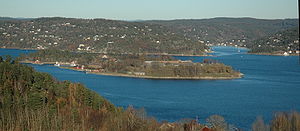Oscarsborg Fortress
| Oscarsborg Fortress | |
|---|---|
| Oslofjord, Norway | |

Oscarsborg Fortress' Main Island seen from the south-west.
|
|
| Type | Coastal fortress |
| Site information | |
| Controlled by | Norway Nazi Germany (1940–1945) |
| Site history | |
| Built | 1846–1855 |
| In use | 23 August 1855 – 28 June 2002 |
| Battles/wars | Battle of Drøbak Sound |
| Garrison information | |
| Past commanders |
Oberst Birger Eriksen |
Oscarsborg Fortress (Norwegian: Oscarsborg festning) is a coastal fortress in the Oslofjord, close to the small town of Drøbak. The best known part is situated on two small islets. The main artillery batteries are on the island Håøya and smaller batteries on the mainland to the west and east in the fjord and was military territory until 2003 when it was made a publicly available resort island. The fortress is best known for sinking the German heavy cruiser Blücher on 9 April 1940. In 2014, Oscarsborg Fortress was given protected status, effective from 9 April that year.
The narrows at Drøbak, called Drøbaksundet, is a natural point for the naval defence of Oslo, the capital of Norway. The first defences were constructed during the reign of Christian IV of Denmark and Norway and were ready in 1644. The fortifications were however not involved in battle during the Hannibal War.
After the war the fortifications were dismantled, and only resurrected for a short period during the 1814 war with Sweden.
Around 1830 the discussion started for a renewed fortification of the Drøbak Narrows and the first stage was ready in 1848, the next in 1853. The name of the fortress was given by royal resolution on 23 August 1855 after a visit by the Swedish-Norwegian King Oscar I.
By the end of the 19th century the art of war developed rapidly and the new fortress was soon obsolete. The tension was also growing between the two countries in the union and so the Norwegians decided to upgrade the fortress. From 1890 new improved German guns were installed, an underwater barrier was built in 1874–79, and an underwater torpedo battery was constructed. The main armament was three 28 cm calibre guns manufactured by Krupp. There were also a number of guns with smaller calibres (15 cm and 57 mm) on the mainland. An underwater barrier went from the main islet of Kaholmen and south-west to Hurum on the western side of the fjord, thus making it impossible for large vessels to sail west of the fortress.
...
Wikipedia
